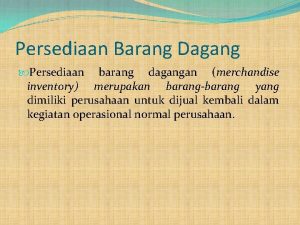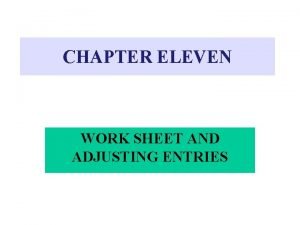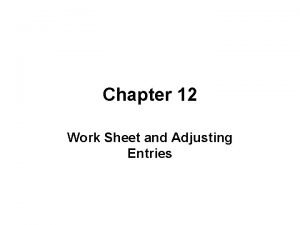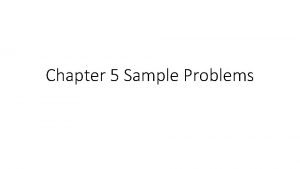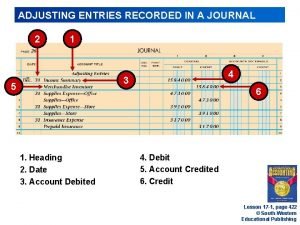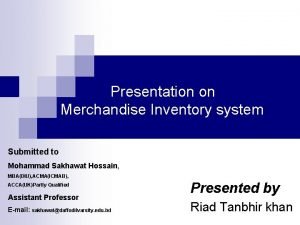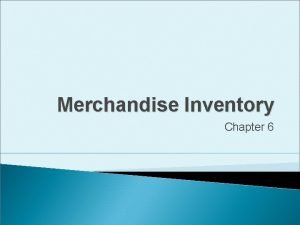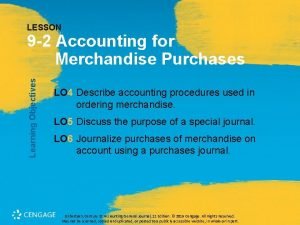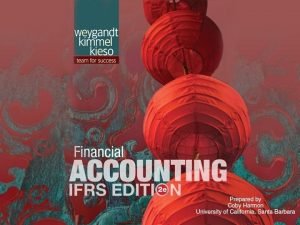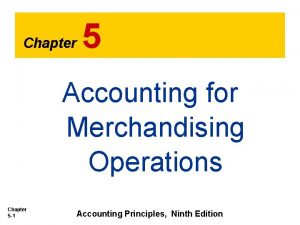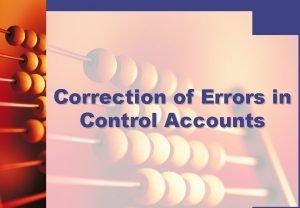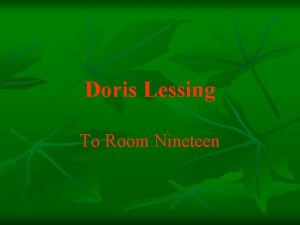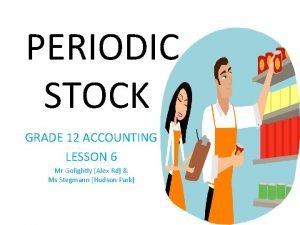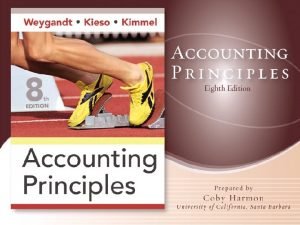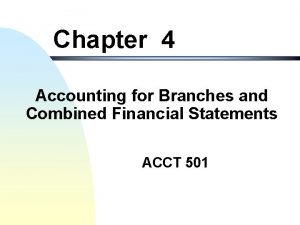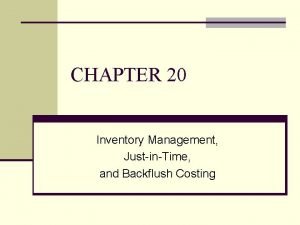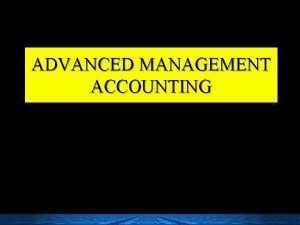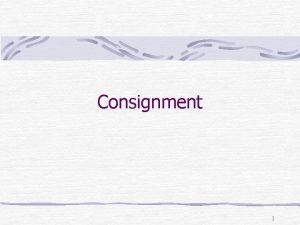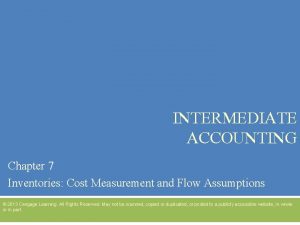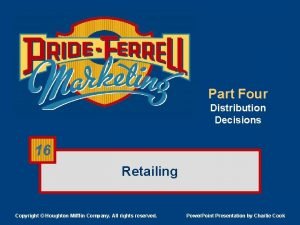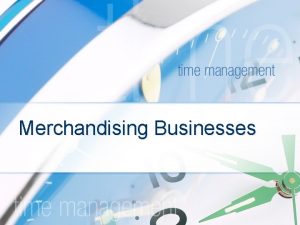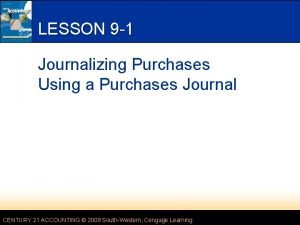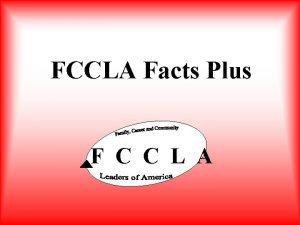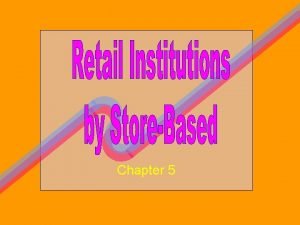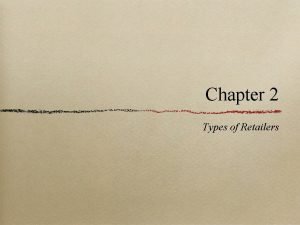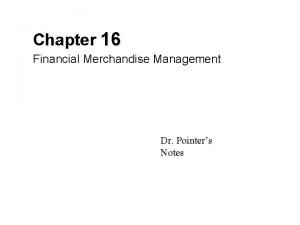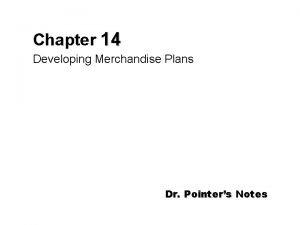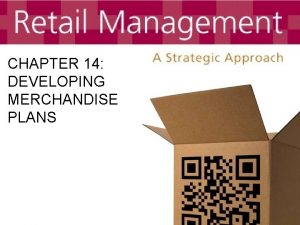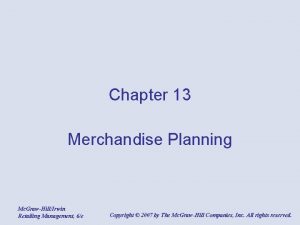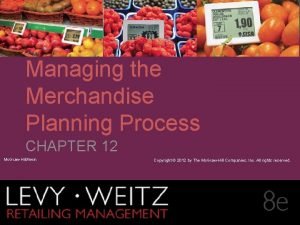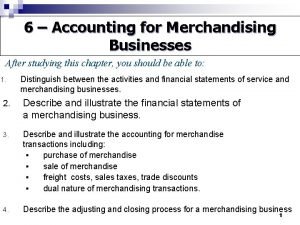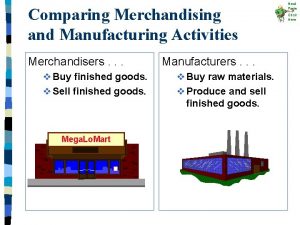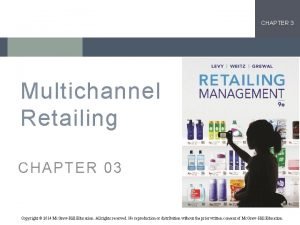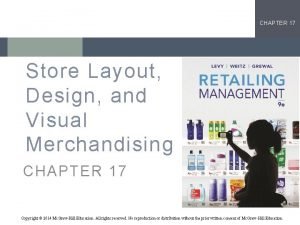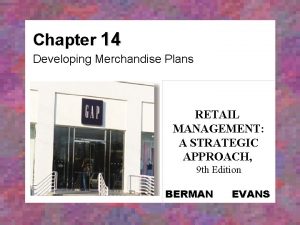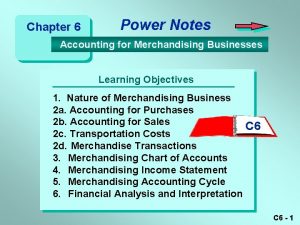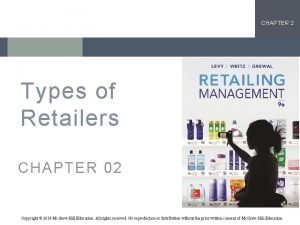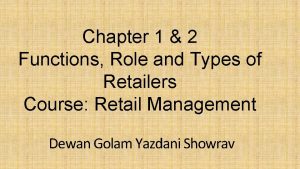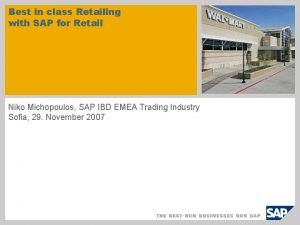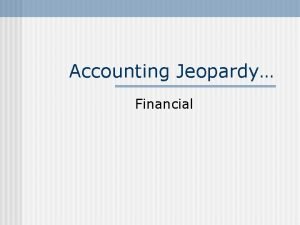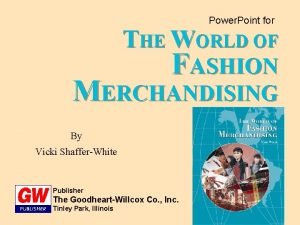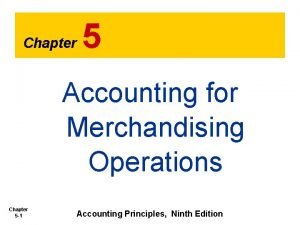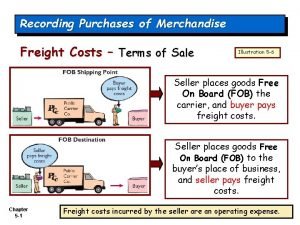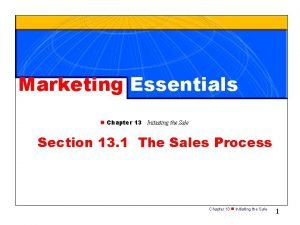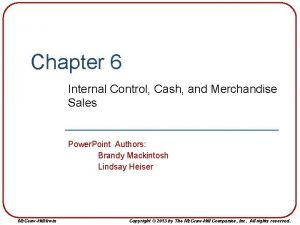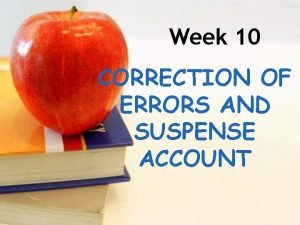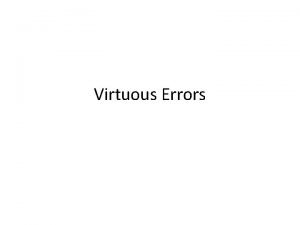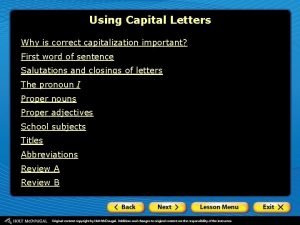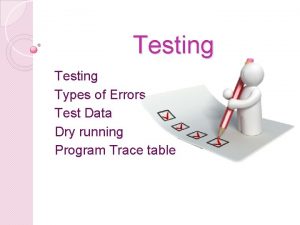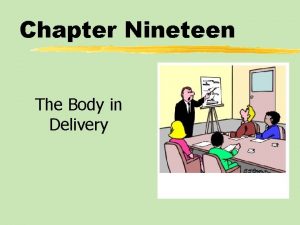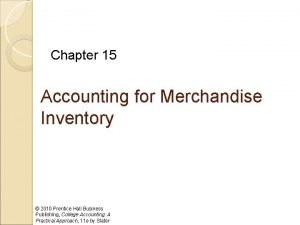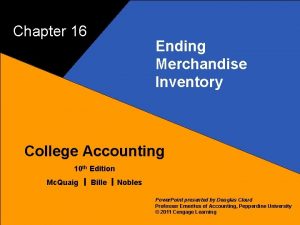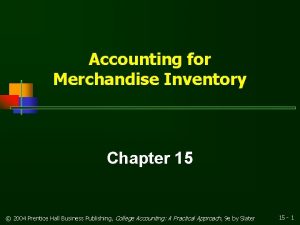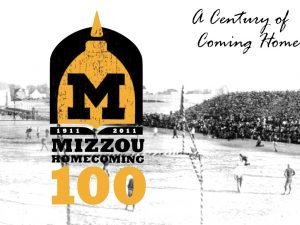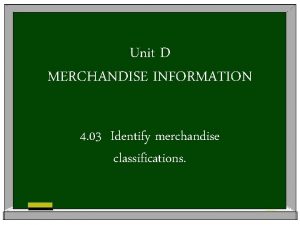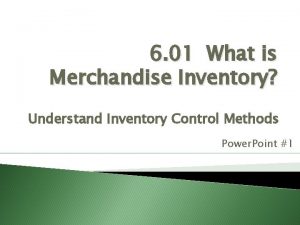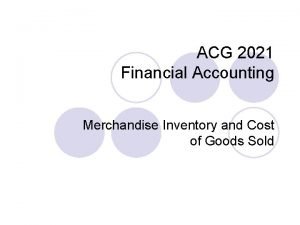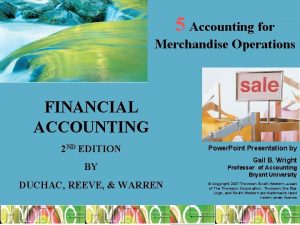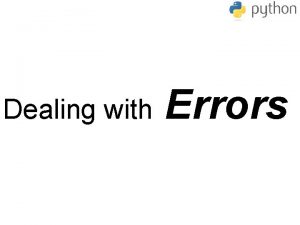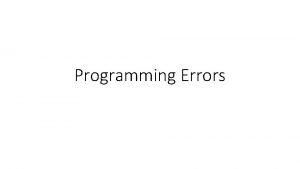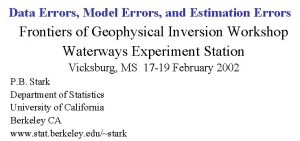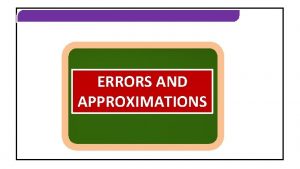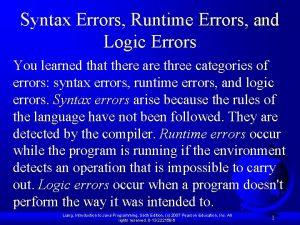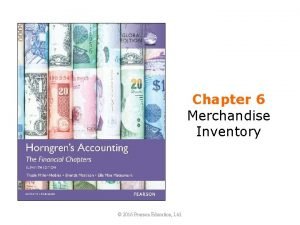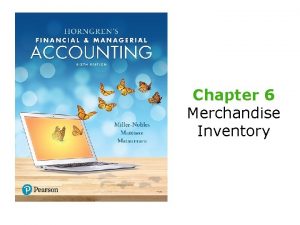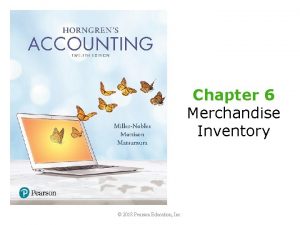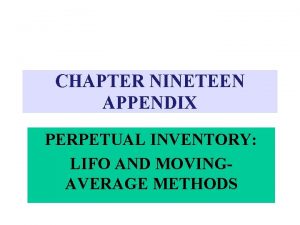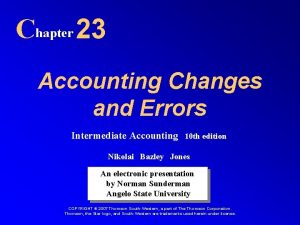CHAPTER NINETEEN ACCOUNTING FOR MERCHANDISE INVENTORY INVENTORY ERRORS











































































































































- Slides: 139

CHAPTER NINETEEN ACCOUNTING FOR MERCHANDISE INVENTORY

INVENTORY ERRORS § Errors in inventory will cause errors on: o Income Statement, Statement of Owner’s Equity and Balance Sheet • For the current and the next year

EFFECT OF INVENTORY ERRORS INCOME STATEMENT Sales Cost of Goods Sold: Beginning Merch. Inventory Add Purchases (net) Cost of Goods Available for Sale Less: Ending Merch. Inventory 20 -1 20 -2 80 20 40 60 20 Let’s first look at the Income Statement with the ending inventory correctly stated at $20.

EFFECT OF INVENTORY ERRORS INCOME STATEMENT Sales Cost of Goods Sold: Beginning Merch. Inventory Add Purchases (net) Cost of Goods Available for Sale Less: Ending Merch. Inventory Cost of Goods Sold Gross Profit Operating Expenses Net Income 20 -1 20 -2 80 20 40 60 20 (40) 40 (10) 30 Now let’s look at the other financial statements.

EFFECT OF INVENTORY ERRORS STMT OF OWNER’S EQUITY Erv Bultman, capital, January 1 Net Income Erv Bultman, capital, December 31 20 -2 100 30 130 BALANCE SHEET (partial) Current Assets: Merchandise Inventory Owner’s Equity: Erv Bultman, Capital 20 130

EFFECT OF INVENTORY ERRORS INCOME STATEMENT 20 -1 20 -2 Sales 80 Cost of Goods Sold: Beginning Merch. Inventory 20 20 Add Purchases (net) 40 Cost of Goods Available for Sale 60 Less: Ending Merch. Inventory 20 (40) Cost of Goods Sold Gross Profit 40 Operating Expenses (10) 20 -1’s ending inventory becomes Net Income 30 20 -2’s beginning inventory. 80

EFFECT OF INVENTORY ERRORS INCOME STATEMENT Sales Cost of Goods Sold: Beginning Merch. Inventory Add Purchases (net) Cost of Goods Available for Sale Less: Ending Merch. Inventory Cost of Goods Sold Gross Profit Operating Expenses Net Income 20 -1 20 -2 80 20 40 60 20 (40) 40 (10) 30

EFFECT OF INVENTORY ERRORS STMT OF OWNER’S EQUITY Erv Bultman, capital, January 1 Net Income Erv Bultman, capital, December 31 20 -2 100 30 130 160 20 20 130 160 BALANCE SHEET (partial) Current Assets: Merchandise Inventory Owner’s Equity: Erv Bultman, Capital

EFFECT OF INVENTORY ERRORS What would be the effect on the financial statements for 20 -1 & 20 -2 if the 12/31/-1 inventory was reported as $15 instead of $20? Ending inventory 20 -1 & Beginning inventory 20 -2 UNDERSTATED

EFFECT OF INVENTORY ERRORS INCOME STATEMENT Sales Cost of Goods Sold: Beginning Merch. Inventory Add Purchases (net) Cost of Goods Available for Sale Less: Ending Merch. Inventory Cost of Goods Sold Gross Profit Operating Expenses Net Income 20 -1 20 -2 80 20 40 60 15 (45) 35 (10) 25 Understated Ending Inventory results in understated Net Income.

EFFECT OF INVENTORY ERRORS STMT OF OWNER’S EQUITY Erv Bultman, capital, January 1 Net Income Erv Bultman, capital, December 31 BALANCE SHEET (partial) 20 -1 100 25 125 Current Assets: Understated Merchandise Inventory. Net Income results in understated Owner’s Equity: Erv Bultman, Capital 20 -2

EFFECT OF INVENTORY ERRORS STMT OF OWNER’S EQUITY Erv Bultman, capital, January 1 Net Income Erv Bultman, capital, December 31 20 -2 100 25 125 BALANCE SHEET (partial) Current Assets: Merchandise Inventory Owner’s Equity: Erv Bultman, Capital 15 125 Assets and Owner’s Equity will be understated.

EFFECT OF INVENTORY ERRORS INCOME STATEMENT Sales Cost of Goods Sold: Beginning Merch. Inventory Add Purchases (net) Cost of Goods Available for Sale Less: Ending Merch. Inventory Cost of Goods Sold Gross Profit Operating Expenses Net Income 20 -1 20 -2 80 20 40 60 15 80 15 40 55 20 (45) 35 (10) 25 (35) 45 (10) 35 Understated Beginning Inventory results in overstated Net Income.

EFFECT OF INVENTORY ERRORS STMT OF OWNER’S EQUITY Erv Bultman, capital, January 1 Net Income Erv Bultman, capital, December 31 20 -2 100 25 125 35 125 160 BALANCE SHEET (partial) Current Assets: Merchandise Inventory Owner’s Equity: Erv Bultman, Capital 15 125 Owner’s Equity is correct by the end of 20 -2.

EFFECT OF INVENTORY ERRORS STMT OF OWNER’S EQUITY Erv Bultman, capital, January 1 Net Income Erv Bultman, capital, December 31 20 -2 100 25 125 35 125 160 15 20 125 160 BALANCE SHEET (partial) Current Assets: Merchandise Inventory Owner’s Equity: Erv Bultman, Capital Assets and Owner’s Equity will be correct.

EFFECT OF INVENTORY ERRORS What would be the effect on the financial statements for 20 -1 & 20 -2 if the 12/31/-1 inventory was reported as $25 instead of $20? Ending inventory 20 -1 & Beginning inventory 20 -2 OVERSTATED

EFFECT OF INVENTORY ERRORS INCOME STATEMENT Sales Cost of Goods Sold: Beginning Merch. Inventory Add Purchases (net) Cost of Goods Available for Sale Less: Ending Merch. Inventory Cost of Goods Sold Gross Profit Operating Expenses Net Income 20 -1 20 -2 80 20 40 60 25 (35) 45 (10) 35 Overstated Ending Inventory results in overstated Net Income.

EFFECT OF INVENTORY ERRORS STMT OF OWNER’S EQUITY Erv Bultman, capital, January 1 Net Income Erv Bultman, capital, December 31 20 -1 100 35 135 BALANCE SHEET (partial) Current Assets: Merchandise Inventory Owner’s Equity: Overstated Net Income results in Erv Bultman, overstated Capital Owner’s Equity. 20 -2

EFFECT OF INVENTORY ERRORS STMT OF OWNER’S EQUITY Erv Bultman, capital, January 1 Net Income Erv Bultman, capital, December 31 20 -2 100 35 135 BALANCE SHEET (partial) Current Assets: Merchandise Inventory Owner’s Equity: Erv Bultman, Capital 25 135 Assets and Owner’s Equity will be overstated.

EFFECT OF INVENTORY ERRORS INCOME STATEMENT Sales Cost of Goods Sold: Beginning Merch. Inventory Add Purchases (net) Cost of Goods Available for Sale Less: Ending Merch. Inventory Cost of Goods Sold Gross Profit Operating Expenses Net Income 20 -1 20 -2 80 20 40 60 25 80 25 40 65 20 (35) 45 (10) 35 (45) 35 (10) 25 Overstated Beginning Inventory results in understated Net Income.

EFFECT OF INVENTORY ERRORS STMT OF OWNER’S EQUITY Erv Bultman, capital, January 1 Net Income Erv Bultman, capital, December 31 20 -2 100 35 135 25 135 160 BALANCE SHEET (partial) Current Assets: Merchandise Inventory Owner’s Equity: Erv Bultman, Capital 25 135 Owner’s Equity is correct by the end of 20 -2.

EFFECT OF INVENTORY ERRORS STMT OF OWNER’S EQUITY Erv Bultman, capital, January 1 Net Income Erv Bultman, capital, December 31 20 -2 100 35 135 25 135 160 25 20 135 160 BALANCE SHEET (partial) Current Assets: Merchandise Inventory Owner’s Equity: Erv Bultman, Capital Assets and Owner’s Equity will be correct.

RECORDING PURCHASES § PERIODIC METHOD o Merch. Inv. account balance = most recent physical inventory o Purchases account used for all merchandise purchases o Current inventory and cost of goods sold only computed at end of period § PERPETUAL METHOD o Merch. Inv. Account reflects current inventory o Purchases are debited to Merch. Inv. , cost of sales are credited to Merch. Inv. o Generally no need for end of year adjustments

COMPARING ENTRIES UNDER PERIODIC AND PERPETUAL SYSTEMS Example: Purchased $100 of merchandise on account

PERIODIC SYSTEM DATE 1 2 3 4 5 6 7 8 9 10 11 DESCRIPTION Purchases Accts Payable Periodic system uses a “Purchases” account. PR DEBIT CREDIT 100 00

PERPETUAL SYSTEM DATE 1 2 3 4 5 6 7 8 9 10 11 DESCRIPTION Merchandise Inventory Accts Payable PR DEBIT CREDIT 100 00 Perpetual system records purchases directly in the Merchandise Inventory account. 100 00

COMPARING ENTRIES UNDER PERIODIC & PERPETUAL SYSTEMS Example: Paid freight charges $30

PERIODIC SYSTEM DATE 1 2 3 4 DESCRIPTION Frieight-In Cash PR DEBIT CREDIT 30 00 5 6 7 8 9 10 11 Periodic system separates freight charges in to their own account. 30 00

PERPETUAL SYSTEM DATE 1 2 3 4 5 6 7 8 9 10 11 DESCRIPTION Merchandise Inventory Cash PR DEBIT CREDIT 30 00 Perpetual system considers freight charges part of the cost of merchandise and includes them in the inventory account. 30 00

COMPARING ENTRIES UNDER PERIODIC & PERPETUAL SYSTEMS Example: Sold merchandise on account, $80. The cost of the merchandise was $50.

PERIODIC SYSTEM DATE 1 2 3 4 5 6 7 8 9 10 11 DESCRIPTION Accounts Receivable Sales PR DEBIT CREDIT 80 00 Periodic system only records the selling price of merchandise sold. No attempt is made to reduce the inventory account for items sold. 80 00

PERPETUAL SYSTEM DATE 1 2 3 4 5 6 7 8 9 10 11 DESCRIPTION Accounts Receivable Sales PR DEBIT CREDIT 80 00 Perpetual system also records the selling price of merchandise sold. 80 00

PERPETUAL SYSTEM DATE 1 2 3 4 5 DESCRIPTION Accounts Receivable Sales Cost of Goods Sold Merchandise Inventory PR DEBIT CREDIT 80 00 50 00 6 7 8 9 10 11 In addition, the perpetual system removes the cost of merchandise sold from inventory. 50 00

COMPARING ENTRIES UNDER PERIODIC & PERPETUAL SYSTEMS Example: Merchandise costing $10 was returned to the supplier.

PERIODIC SYSTEM DATE 1 2 3 4 DESCRIPTION Accounts Payable Purchases Ret. & Allow. PR DEBIT CREDIT 10 00 5 6 7 8 9 10 11 Periodic system maintains a separate account for returns. 10 00

PERPETUAL SYSTEM DATE 1 2 3 4 5 6 7 8 9 10 11 DESCRIPTION Accounts Payable Merchandise Inventory PR DEBIT CREDIT 80 00 Since the merchandise was recorded in the inventory account when purchased, it is removed from the account when returned. 80 00

COMPARING ENTRIES UNDER PERIODIC & PERPETUAL SYSTEMS Example: Customers returned merchandise sold for $20. The cost of the merchandise was $15.

PERIODIC SYSTEM DATE 1 2 3 4 DESCRIPTION Sales Returns & Allow. Accounts Receivable PR DEBIT CREDIT 20 00 5 6 7 8 9 10 11 Periodic system maintains a separate account for returns. 20 00

PERPETUAL SYSTEM DATE 1 2 3 4 5 6 7 8 9 10 11 DESCRIPTION Sales Returns & Allow. Accounts Receivable PR DEBIT CREDIT 20 00 Perpetual system records the returned sale. It also must adjust the “Cost of Goods Sold” and “Merchandise Inventory” accounts. 20 00

PERPETUAL SYSTEM DATE 1 2 3 4 5 6 7 8 9 10 11 DESCRIPTION Sales Returns & Allow. Accounts Receivable Merchandise Inventory Cost of Goods Sold PR DEBIT CREDIT 20 00 15 00

COMPARING ENTRIES UNDER PERIODIC & PERPETUAL SYSTEMS Example: Paid for merchandise costing $100. The supplier granted a 2% discount for prompt payment.

PERIODIC SYSTEM DATE 1 2 3 4 DESCRIPTION Accounts Payable Purchases Discounts Cash PR DEBIT CREDIT 100 00 5 6 7 8 9 10 11 Discounts are recorded in a separate account. 2 00 98 00

PERPETUAL SYSTEM DATE 1 2 3 4 5 6 7 8 9 10 11 DESCRIPTION Sales Returns & Allow. Accounts Receivable PR DEBIT CREDIT 20 00 Perpetual system records the returned sale. It also must adjust the “Cost of Goods Sold” and “Merchandise Inventory” accounts. 20 00

COMPARING ENTRIES UNDER PERIODIC & PERPETUAL SYSTEMS Example: Adjusting entries made at the end of the accounting period.

PERIODIC SYSTEM DATE 1 2 3 4 5 6 7 8 9 10 11 DESCRIPTION PR DEBIT CREDIT Income Summary Merchandise Inventory Removing the old balance from the inventory account XX XX

PERIODIC SYSTEM DATE 1 2 3 4 5 DESCRIPTION PR DEBIT CREDIT Income Summary Merchandise Inventory XX Merchandise Inventory Income Summary XX 6 7 8 9 10 11 Recording new balance in the inventory account XX XX

PERPETUAL SYSTEM DATE 1 2 3 4 5 6 7 8 9 10 11 DESCRIPTION PR DEBIT CREDIT No entry needed if physical inventory agrees with amount reported in inventory account.

TAKING A PHYSICAL INVENTORY § Counting the goods on hand at the end of the period o used in the PERIODIC system to allocate merchandise costs between sold and unsold goods o in the PERPETUAL system it is compared to the accounting records to determine if what is actually held agrees with the records o done after regular business hours o ideally when inventory on hand is at its lowest level • fiscal year that starts and ends when inventory is at its lowest level is called “natural business year”

TAKING A PHYSICAL INVENTORY § Two special situations: o Goods held for sale on CONSIGNMENT • Goods held on consignment remain the property of the shipper (Consignor) o Goods in TRANSIT • if FOB Shipping point - goods belong to the BUYER while in transit • if FOB Destination- goods belong to the SELLER while in transit

COMPUTING THE COST OF ENDING INVENTORY EXAMPLE: A physical inventory found 50 bicycles (Model ZX 007) on hand. All of this model bicycle were purchased for $60 each. Number of X bikes on hand 50 X Cost per = unit $60 = Ending Inventory $3000 Computing ending inventory is simple if all purchases were made at the same price.

COMPUTING THE COST OF ENDING INVENTORY What if each time we restocked this bicycle the price had changed? On hand at start of period Purchased during period: 1 st purchase 2 nd purchase 3 rd purchase No. of units available for sale On hand at end of period No. of units sold during period Units 40 Unit Price $62 60 80 70 250 50 200 65 67 68 Total Cost $2, 480 3, 900 5, 360 4, 760 $16, 500 Cost of these 200 sold?

COMPUTING THE COST OF ENDING INVENTORY What if each time we restocked this bicycle the price had changed? Units 40 Unit Price $62 On hand at start of period Purchased during period: 1 st purchase 60 65 Depends on inventory 2 nd purchase 80 67 method used 3 rd purchase 70 68 No. of units available for sale 250 On hand at end of period 50 No. of units sold during period 200 Total Cost $2, 480 3, 900 5, 360 4, 760 $16, 500

INVENTORY METHODS Method #1 - Specific Identification Method 4 Used when each unit of inventory can be specifically identified – examples: cars, motorcycles, furniture, appliances, fine jewelry 4 Only practical for businesses in which sales volume is low and inventory unit value is high Let’s apply this method to the bicycle example.

COMPUTING THE COST OF GOODS SOLD Inventory was maintained using the Specific Identification Method. The 200 bikes sold are as follows: On hand at start of period Purchased during period: 1 st purchase 2 nd purchase 3 rd purchase No. of units available for sale On hand at end of period No. of units sold during period Units 40 60 80 70 250 50 200 Unit Price Total Cost 30$62 of these were sold $2, 480 65 67 68 3, 900 5, 360 4, 760 $16, 500

COMPUTING THE COST OF GOODS SOLD Inventory was maintained using the Specific Identification Method. The 200 bikes sold are as follows: On hand at start of period Purchased during period: 1 st purchase 2 nd purchase 3 rd purchase No. of units available for sale On hand at end of period No. of units sold during period Units 40 Unit Price $62 Total Cost $2, 480 60 80 70 250 50 200 65 these were 3, 900 50 of sold 67 5, 360 68 4, 760 $16, 500

COMPUTING THE COST OF GOODS SOLD Inventory was maintained using the Specific Identification Method. The 200 bikes sold are as follows: On hand at start of period Purchased during period: 1 st purchase 2 nd purchase 3 rd purchase No. of units available for sale On hand at end of period No. of units sold during period Units 40 Unit Price $62 Total Cost $2, 480 60 80 70 250 50 200 3, 900 65 60 of sold 67 these were 5, 360 68 4, 760 $16, 500

COMPUTING THE COST OF GOODS SOLD Inventory was maintained using the Specific Identification Method. The 200 bikes sold are as follows: On hand at start of period Purchased during period: 1 st purchase 2 nd purchase 3 rd purchase No. of units available for sale On hand at end of period No. of units sold during period Units 40 60 80 70 250 50 200 Unit Price $62 Total Cost $2, 480 3, 900 65 67 5, 360 60 68 of these were sold 4, 760 $16, 500

COMPUTING THE COST OF GOODS SOLD Units Sold From beginning inventory 30 1 st purchase 50 2 nd purchase 60 3 rd purchase 60 Total 200 Unit Price $62 65 67 68 Total Cost $1, 860 3, 250 4, 020 4, 760 $13, 210 Cost of goods (the 200 bikes) sold

COMPUTING THE ENDING INVENTORY Units Remaining Unit Price From beginning inventory 10 $62 1 st purchase 10 65 2 nd purchase 20 67 3 rd purchase 10 68 Total 50 Total Cost $620 650 1, 340 680 $3, 290 This ending inventory will be reported on the Income Statement and the Balance Sheet.

INVENTORY METHODS Method #2 - First-In, First-Out (FIFO) Method 4 Assumes the first goods purchased were the first goods sold q. Leaving the most recently purchased goods in ending inventory 4 Follows the natural flow of goods qespecially true of grocery stores, fresh fruit stands, and computer software businesses Let’s apply this method to the bicycle example.

COMPUTING THE COST OF GOODS SOLD Inventory was maintained using the FIFO method. The identity of the 200 bikes sold is as follows: On hand at start of period Purchased during period: 1 st purchase 2 nd purchase 3 rd purchase No. of units available for sale On hand at end of period No. of units sold during period Units 40 60 80 70 250 50 200 Unit Price Total Cost $2, 480 sold All $62 of these - assumed 65 67 68 3, 900 5, 360 4, 760 $16, 500

COMPUTING THE COST OF GOODS SOLD Inventory was maintained using the FIFO method. The identity of the 200 bikes sold is as follows: On hand at start of period Purchased during period: 1 st purchase 2 nd purchase 3 rd purchase No. of units available for sale On hand at end of period No. of units sold during period Units 40 Unit Price $62 Total Cost $2, 480 60 80 70 250 50 200 3, 900 sold All of 65 these - assumed 67 5, 360 68 4, 760 $16, 500

COMPUTING THE COST OF GOODS SOLD Inventory was maintained using the FIFO method. The identity of the 200 bikes sold is as follows: On hand at start of period Purchased during period: 1 st purchase 2 nd purchase 3 rd purchase No. of units available for sale On hand at end of period No. of units sold during period Units 40 Unit Price $62 Total Cost $2, 480 60 80 70 250 50 200 3, 900 65 All 67 of these - assumed 5, 360 sold 68 4, 760 $16, 500

COMPUTING THE COST OF GOODS SOLD Inventory was maintained using the FIFO method. The identity of the 200 bikes sold is as follows: On hand at start of period Purchased during period: 40 1 st purchase 60 2 nd purchase 80 180 considered 3 rd purchase sold so far No. of units available for sale On hand at end of period No. of units sold during period Units 40 Unit Price $62 60 80 70 250 50 200 65 67 68 Total Cost $2, 480 3, 900 5, 360 4, 760 $16, 500

COMPUTING THE COST OF GOODS SOLD Inventory was maintained using the FIFO method. The identity of the 200 bikes sold is as follows: On hand at start of period Purchased during period: 1 st purchase 2 nd purchase 3 rd purchase No. of units available for sale On hand at end of period No. of units sold during period Units 40 Unit Price $62 Total Cost $2, 480 60 80 70 250 50 200 3, 900 65 67 5, 360 20 of 68 these - assumed 4, 760 sold $16, 500

COMPUTING THE COST OF GOODS SOLD Units Sold All of the beginning inventory 40 All of the 1 st purchase 60 All of the 2 nd purchase 80 3 rd purchase 20 Unit Price $62 65 67 Total Cost $2, 480 3, 900 5, 360 The remaining units from this purchase are the 50 units in ending inventory.

COMPUTING THE COST OF GOODS SOLD Units Sold All of the beginning inventory 40 All of the 1 st purchase 60 All of the 2 nd purchase 80 3 rd purchase 20 Total 200 Unit Price $62 65 67 68 Total Cost $2, 480 3, 900 5, 360 1, 360 $13, 100 Cost of goods (the 200 bikes) sold

COMPUTING THE ENDING INVENTORY Units Remaining Unit Price From beginning inventory 0 $62 1 st purchase 0 65 2 nd purchase 0 67 3 rd purchase 50 68 Total 50 Total Cost $ 0 0 0 3, 400 $3, 400 This ending inventory will be reported on the Income Statement and the Balance Sheet.

INVENTORY METHODS Method #3 - Weighted -Average Method 4 Computes an average cost per unit using the following formula: q. Total cost of units available for sale divided by the units available for sale Let’s apply this method to the bicycle example.

COMPUTING THE COST OF GOODS SOLD Inventory was maintained using the Weighted. Average method. On hand at start of period Purchased during period: 1 st purchase 2 nd purchase 3 rd purchase No. of units available for sale On hand at end of period No. of units sold during period Units 40 Unit Price $62 60 80 70 250 50 200 65 67 68 Total Cost $2, 480 3, 900 5, 360 4, 760 $16, 500 = $66/unit 250

WEIGHTED-AVERAGE METHOD Cost of goods sold Ending Inventory 200 units @ $66 = $13, 200 50 units @ $66 = One of the advantages of the Weighted-Average method is its simplicity. 3, 300

INVENTORY METHODS Method #4 - Last-In, First-Out Method 4 Assumes that the sales in the period were made from the most recently purchased goods. q. While oldest goods remain in inventory 4 Use of this method is justified because: q. LIFO is the actual physical flow of goods in some businesses qit matches the most current costs of items purchased against the current sales revenue

COMPUTING THE COST OF GOODS SOLD Inventory was maintained using the LIFO method. The identity of the 200 bikes sold is as follows: On hand at start of period Purchased during period: 1 st purchase 2 nd purchase 3 rd purchase No. of units available for sale On hand at end of period No. of units sold during period Units 40 Unit Price $62 Total Cost $2, 480 60 80 70 250 50 200 3, 900 65 67 5, 360 All 68 of these - assumed 4, 760 sold $16, 500

COMPUTING THE COST OF GOODS SOLD Inventory was maintained using the LIFO method. The identity of the 200 bikes sold is as follows: On hand at start of period Purchased during period: 1 st purchase 2 nd purchase 3 rd purchase No. of units available for sale On hand at end of period No. of units sold during period Units 40 60 80 70 250 50 200 Unit Price $62 Total Cost $2, 480 3, 900 65 All 67 of these - assumed 5, 360 sold 68 4, 760 $16, 500

COMPUTING THE COST OF GOODS SOLD Inventory was maintained using the LIFO method. The identity of the 200 bikes sold is as follows: On hand at start of period Purchased during period: 1 st purchase 70 2 nd purchase 80 3 rd purchase considered No. of units 150 available for sale so far On hand at end sold of period No. of units sold during period Units 40 Unit Price $62 60 80 70 250 50 200 65 67 68 Total Cost $2, 480 3, 900 5, 360 4, 760 $16, 500

COMPUTING THE COST OF GOODS SOLD Inventory was maintained using the LIFO method. The identity of the 200 bikes sold is as follows: On hand at start of period Purchased during period: 1 st purchase 2 nd purchase 3 rd purchase No. of units available for sale On hand at end of period No. of units sold during period Units 40 Unit Price $62 Total Cost $2, 480 60 80 70 250 50 200 3, 900 sold 50 of 65 these - assumed 67 5, 360 68 4, 760 $16, 500

COMPUTING THE COST OF GOODS SOLD Units Sold None of the beginning inventory 0 1 st purchase 50 All of the 2 nd purchase 80 All of the 3 rd purchase 70 200 Unit Price $62 65 67 68 Total Cost $ 0 3, 250 5, 360 4, 760 $13, 370

COMPUTING THE ENDING INVENTORY Units Remaining Unit Price From beginning inventory 40 $62 1 st purchase 10 65 2 nd purchase 0 67 3 rd purchase 0 68 Total 50 Total Cost $2, 480 650 0 0 $3, 130 This ending inventory will be reported on the Income Statement and the Balance Sheet.

COMPARISON OF METHODS § Assumed cost flows (FIFO, Weighed. Average, and LIFO) do not have to match the actual physical movement of goods. § Any one of the methods may be used under any set of physical flow conditions.

COMPARISON OF METHODS Sales Cost of Goods Sold: Beg. Inventory Purchases Goods Avail. for Sale Specific Identification $18, 000 $ 2, 480 14, 020 $16, 500 FIFO $18, 000 $ 2, 480 14, 020 $16, 500 Goods Available for Sale is the same for all four methods!

COMPARISON OF METHODS FIFO $18, 000 $ 2, 480 14, 020 $16, 500 Weigthed-Average $18, 000 $ 2, 480 14, 020 $16, 500 LIFO $18, 000 $ 2, 480 14, 020 $16, 500

COMPARISON OF METHODS Specific Identification $18, 000 Sales Cost of Goods Sold: Beg. Inventory $ 2, 480 Purchases 14, 020 Goods Avail. for Sale $16, 500 Less ending inventory 3, 290 Cost of goods sold FIFO $18, 000 $ 2, 480 14, 020 $16, 500 3, 400 13, 210 13, 100 Ending Inventory & Cost of Goods Sold differ with each method.

COMPARISON OF METHODS FIFO $18, 000 $ 2, 480 14, 020 $16, 500 3, 400 Weigthed-Average $18, 000 $ 2, 480 14, 020 $16, 500 3, 300 13, 100 LIFO $18, 000 $ 2, 480 14, 020 $16, 500 3, 130 13, 200 13, 370

COMPARISON OF METHODS Specific Identification $18, 000 Sales Cost of Goods Sold: Beg. Inventory $ 2, 480 Purchases 14, 020 Goods Avail. for Sale $16, 500 Less ending inventory 3, 290 Cost of goods sold Gross Profit FIFO $18, 000 $ 2, 480 14, 020 $16, 500 3, 400 13, 210 $ 4, 790 13, 100 $ 4, 900

COMPARISON OF METHODS FIFO $18, 000 $ 2, 480 14, 020 $16, 500 3, 400 Weigthed-Average $18, 000 $ 2, 480 14, 020 $16, 500 3, 300 13, 100 $ 4, 900 LIFO $18, 000 $ 2, 480 14, 020 $16, 500 3, 130 13, 200 $ 4, 800 13, 370 $ 4, 630 When prices are rising (as with the bikes) FIFO results in the largest Gross Profit.

COMPARISON OF METHODS FIFO $18, 000 $ 2, 480 14, 020 $16, 500 3, 400 Weigthed-Average $18, 000 $ 2, 480 14, 020 $16, 500 3, 300 13, 100 $ 4, 900 LIFO $18, 000 $ 2, 480 14, 020 $16, 500 3, 130 13, 200 $ 4, 800 13, 370 $ 4, 630 LIFO results in the smallest Gross Profit, therefore creating the smallest tax liability.

PERPETUAL SYSTEM § Merchandise Inventory is a controlling account. o Subsidiary ledger maintained for each product § Costs can be assigned on a FIFO, movingaverage or LIFO basis.

PERPETUAL FIFO METHOD Let’s return to the example of the 200 bicycles sold. Date Purchases Cost of Goods Sold Cost/ Cumulative Units Unit Total Units Unit CGS Jan. 1 (BI) There were 40 bicycles in inventory at the beginning of the year.

PERPETUAL FIFO METHOD Let’s return to the example of the 200 bicycles sold. Cost of Goods Sold Inventory on Hand Cost/ Cumulative Cost/ Layer Units Unit CGS Layer Units Unit Cost Total (1) 40 $62 Each of the 40 units were purchased at $62. $2, 480

PERPETUAL FIFO METHOD Let’s return to the example of the 200 bicycles sold. Date Purchases Cost of Goods Sold Cost/ Cumulative Units Unit Total Units Unit CGS Jan. 1 (BI) Feb. 15 30 $ 62 The 30 bikes sold came from the $62 bikes in beginning inventory.

PERPETUAL FIFO METHOD Let’s return to the example of the 200 bicycles sold. Date Purchases Cost of Goods Sold Cost/ Cumulative Units Unit Total Units Unit CGS Jan. 1 (BI) Feb. 15 30 $ 62 $ 1, 860

PERPETUAL FIFO METHOD Let’s return to the example of the 200 bicycles sold. Cost of Goods Sold Inventory on Hand Cost/ Cumulative Cost/ Layer Units Unit CGS Layer Units Unit Cost Total 30 $ 62 $ 1, 860 (1) 40 $62 $2, 480 10 $62 620 $ 620

PERPETUAL FIFO METHOD Let’s return to the example of the 200 bicycles sold. Date Purchases Cost of Goods Sold Cost/ Cumulative Units Unit Total Units Unit CGS Jan. 1 (BI) Feb. 15 Mar. 1 30 60 $ 65 $ 3, 900 $ 62 $ 1, 860

PERPETUAL FIFO METHOD Let’s return to the example of the 200 bicycles sold. Cost of Goods Sold Inventory on Hand Cost/ Cumulative Cost/ Layer Units Unit CGS Layer Units Unit Cost Total 30 $ 62 $ 1, 860 (1) (1) (2) 40 $62 $2, 480 10 10 60 $62 65 620 $ 620 3, 900 $4, 520 Now there are two layers in inventory… 10 bikes from the beginning inventory and the 60 bikes just purchased.

PERPETUAL FIFO METHOD Let’s return to the example of the 200 bicycles sold. Date Purchases Cost of Goods Sold Cost/ Cumulative Units Unit Total Units Unit CGS Jan. 1 (BI) Feb. 15 Mar. 1 April 1 30 60 $ 62 $ 1, 860 $ 65 $ 3, 900 On April 1, 40 units were sold. $ 1, 860

PERPETUAL FIFO METHOD Let’s return to the example of the 200 bicycles sold. Cost of Goods Sold Inventory on Hand Cost/ Cumulative Cost/ Layer Units Unit CGS Layer Units Unit Cost Total 30 $ 62 $ 1, 860 (1) (1) (2) 40 $62 $2, 480 10 10 60 $62 65 620 $ 620 3, 900 $4, 520 FIFO assumes the first-in are the first sold…. 40 sold = 10 from the beginning inventory and the 30 from the 3/1 purchase.

PERPETUAL FIFO METHOD Let’s return to the example of the 200 bicycles sold. Date Purchases Cost of Goods Sold Cost/ Cumulative Units Unit Total Units Unit CGS Jan. 1 (BI) Feb. 15 Mar. 1 April 1 60 $ 65 $ 3, 900 30 $ 62 $ 1, 860 10 30 $ 620 65 1, 950 $ 4, 430

PERPETUAL FIFO METHOD Let’s return to the example of the 200 bicycles sold. Cost of Goods Sold Inventory on Hand Cost/ Cumulative Cost/ Layer Units Unit CGS Layer Units Unit Cost Total 30 $ 62 $ 1, 860 10 30 $ 620 65 1, 950 (1) $ 1, 860 (1) (2) $ 4, 430 40 $62 $2, 480 10 10 60 30 $62 65 $65 620 $ 620 3, 900 $4, 520 1, 950 $1, 950

PERPETUAL FIFO METHOD Let’s return to the example of the 200 bicycles sold. Date Purchases Cost of Goods Sold Cost/ Cumulative Units Unit Total Units Unit CGS Jan. 1 (BI) Feb. 15 Mar. 1 April 1 60 $ 65 $ 3, 900 May 15 80 $ 67 $ 5, 360 30 $ 62 $ 1, 860 10 30 $ 620 65 1, 950 $ 4, 430

PERPETUAL FIFO METHOD Let’s return to the example of the 200 bicycles sold. Cost of Goods Sold Inventory on Hand Cost/ Cumulative Cost/ Layer Units Unit CGS Layer Units Unit Cost Total 30 $ 62 $ 1, 860 10 30 $ 620 65 1, 950 (1) $ 1, 860 (1) (2) $ 4, 430 (2) (3) 40 $62 $2, 480 10 10 60 30 $62 65 $65 30 80 $65 67 620 $ 620 3, 900 $4, 520 1, 950 $1, 950 5, 360 $7, 310

PERPETUAL FIFO METHOD Let’s return to the example of the 200 bicycles sold. Date Purchases Cost of Goods Sold Cost/ Cumulative Units Unit Total Units Unit CGS May 15 June 30 80 $ 67 $ 5, 360 On June 30, 90 units were sold.

PERPETUAL FIFO METHOD Let’s return to the example of the 200 bicycles sold. Cost of Goods Sold Inventory on Hand Cost/ Cumulative Cost/ Layer Units Unit CGS Layer Units Unit Cost Total (2) 30 $65 1, 950 (3) 80 67 5, 360 $7, 310 90 bikes sold = 30 (layer 2) + 60 (layer 3)

PERPETUAL FIFO METHOD Let’s return to the example of the 200 bicycles sold. Date Purchases Cost of Goods Sold Cost/ Cumulative Units Unit Total Units Unit CGS May 15 June 30 80 $ 67 $ 5, 360 30 60 $65 1, 950 67 4, 020 $ 10, 400

PERPETUAL FIFO METHOD Let’s return to the example of the 200 bicycles sold. Cost of Goods Sold Inventory on Hand Cost/ Cumulative Cost/ Layer Units Unit CGS Layer Units Unit Cost Total (2) 30 $65 1, 950 (3) 80 67 5, 360 $7, 310 30 $65 1, 950 20 67 1, 340 (3) $1, 340 60 67 4, 020 $ 10, 400

PERPETUAL FIFO METHOD Let’s return to the example of the 200 bicycles sold. Date Purchases Cost of Goods Sold Cost/ Cumulative Units Unit Total Units Unit CGS May 15 June 30 80 $ 67 $ 5, 360 70 $ 68 $ 4, 760 Aug. 28 30 60 $65 1, 950 67 4, 020 $ 10, 400

PERPETUAL FIFO METHOD Let’s return to the example of the 200 bicycles sold. Cost of Goods Sold Inventory on Hand Cost/ Cumulative Cost/ Layer Units Unit CGS Layer Units Unit Cost (2) 30 $65 1, 950 (3) 80 67 5, 360 30 $65 1, 950 20 $67 1, 340 (3) 60 67 4, 020 $ 10, 400 (3) 20 $67 1, 340 (4) 70 68 4, 760 Total $7, 310 $1, 340 $6, 100

PERPETUAL FIFO METHOD Let’s return to the example of the 200 bicycles sold. Date Purchases Cost of Goods Sold Cost/ Cumulative Units Unit Total Units Unit CGS May 15 June 30 80 $ 67 $ 5, 360 70 $ 68 $ 4, 760 30 60 $65 1, 950 67 4, 020 $ 10, 400 Aug. 28 Oct. 30 40 units were sold on Oct. 30.

PERPETUAL FIFO METHOD Let’s return to the example of the 200 bicycles sold. Cost of Goods Sold Inventory on Hand Cost/ Cumulative Cost/ Layer Units Unit CGS Layer Units Unit Cost (2) 30 $65 1, 950 (3) 80 67 5, 360 30 $65 1, 950 20 $67 1, 340 (3) 60 67 4, 020 $ 10, 400 (3) 20 $67 1, 340 (4) 70 68 4, 760 40 units sold = 20 (layer 3) + 20 (layer 4) Total $7, 310 $1, 340 $6, 100

PERPETUAL FIFO METHOD Let’s return to the example of the 200 bicycles sold. Date Purchases Cost of Goods Sold Cost/ Cumulative Units Unit Total Units Unit CGS May 15 June 30 80 $ 67 $ 5, 360 70 $ 68 $ 4, 760 30 60 $65 $1, 950 67 4, 020 $ 10, 400 20 20 $67 $1, 340 68 1, 360 $ 13, 100 Aug. 28 Oct. 30

PERPETUAL FIFO METHOD Let’s return to the example of the 200 bicycles sold. Cost of Goods Sold Inventory on Hand Cost/ Cumulative Cost/ Layer Units Unit CGS Layer Units Unit Cost (2) 30 $65 1, 950 (3) 80 67 5, 360 30 $65 1, 950 20 $67 1, 340 (3) 60 67 4, 020 $ 10, 400 (3) 20 $67 1, 340 (4) 70 68 4, 760 20 $67 $1, 340 (4) 50 $68 3, 400 20 68 1, 360 $ 13, 100 Cost of Goods Sold for the year Total $7, 310 $1, 340 $6, 100 $3, 400

PERPETUAL FIFO METHOD Let’s return to the example of the 200 bicycles sold. Cost of Goods Sold Inventory on Hand Cost/ Cumulative Cost/ Layer Units Unit CGS Layer Units Unit Cost (2) 30 $65 1, 950 (3) 80 67 5, 360 30 $65 1, 950 20 $67 1, 340 (3) 60 67 4, 020 $ 10, 400 (3) 20 $67 1, 340 (4) 70 68 4, 760 20 $67 $1, 340 (4) 50 $68 3, 400 20 68 1, 360 $ 13, 100 Ending Inventory Total $7, 310 $1, 340 $6, 100 $3, 400

PHYSICAL INVENTORY 4 Perpetual system does not eliminate the need for a physical inventory. 4 Records are compared with the physical inventory. q. If a difference is found, an adjusting entry must be prepared qdifferences are recorded in “Inventory Short and Over” account

PHYSICAL INVENTORY Example: A physical inventory shows $3, 710 worth of merchandise, but the inventory account has a balance of $3, 840. $130 short

GENERAL JOURNAL DATE 1 2 3 4 Dec DESCRIPTION 31 Inventory Short and Over Merchandise Inventory To adjust inventory per physical count 5 6 7 8 9 10 11 If physical count had shown $3, 900… $60 overage PR DEBIT CREDIT 130

GENERAL JOURNAL DATE 1 2 3 4 5 6 7 8 9 10 11 Dec DESCRIPTION 31 Merchandise Inventory Short and Over To adjust inventory per physical count PR DEBIT CREDIT 60 60

CONSERVATISM PRINCIPLE § Assets that increase in value while being held…. o No formal entry of the gain is made until asset is sold § Assets that decrease in value while being held…. o An entry is made to recognize the loss § We never anticipate gains, but we should always anticipate and account for losses.

LOWER OF COST OR MARKET § If the value of inventory declines while it is being held, the loss should be recognized in the period of the decline. § “Cost” o the dollar amount calculated using one of the four costing methods § “Market” o the cost to replace the inventory

LOWER OF COST OR MARKET Item Recorded Purchase Cost End-of-Period Market Value Lower-of-Cost-or -Market 1 2 3 This company sells three products.

LOWER OF COST OR MARKET Item 1 Recorded Purchase Cost End-of-Period Market Value Lower-of-Cost-or -Market $ 8, 000 2 3 The inventory of product #1 cost $8, 000.

LOWER OF COST OR MARKET Item 1 Recorded Purchase Cost $ 8, 000 End-of-Period Market Value $ 7, 000 2 3 But the price has fallen, it now could be replaced for $7, 000. Lower-of-Cost-or -Market

LOWER OF COST OR MARKET Item 1 Recorded Purchase Cost $ 8, 000 End-of-Period Market Value $ 7, 000 2 3 “Market” is the lowest Lower-of-Cost-or -Market $ 7, 000

LOWER OF COST OR MARKET Item Recorded Purchase Cost End-of-Period Market Value Lower-of-Cost-or -Market 1 $ 8, 000 $ 7, 000 2 9, 000 10, 000 9, 000 3 7, 000 $24, 000 6, 500 $23, 500 6, 500 $22, 500 Two ways to calculate Lower-of-Cost-or-Market

LOWER OF COST OR MARKET Item Recorded Purchase Cost End-of-Period Market Value Lower-of-Cost-or -Market 1 $ 8, 000 $ 7, 000 2 9, 000 10, 000 9, 000 3 7, 000 $24, 000 6, 500 $23, 500 6, 500 $22, 500 #1 - Applied to Total Inventory The lower of all items at their cost or all items at their market value

LOWER OF COST OR MARKET Item Recorded Purchase Cost End-of-Period Market Value Lower-of-Cost-or -Market 1 $ 8, 000 $ 7, 000 2 9, 000 10, 000 9, 000 3 7, 000 $24, 000 6, 500 $23, 500 6, 500 $22, 500 #2 - Applied to Each Item Each item is evaluated, lowest amount is selected for each item

LOWER OF COST OR MARKET Item Recorded Purchase Cost End-of-Period Market Value Lower-of-Cost-or -Market 1 $ 8, 000 $ 7, 000 2 9, 000 10, 000 9, 000 3 7, 000 $24, 000 6, 500 $23, 500 6, 500 $22, 500 Let’s assume it was applied to Total Inventory. A journal entry is needed to reduce Merchandise Inventory to $23, 500.

GENERAL JOURNAL DATE 1 Expense 2 3 4 5 6 7 8 9 10 11 DESCRIPTION PR DEBIT CREDIT Loss on Write-Down of Inventory 500 Merchandise Inventory To recognize loss in value of inventory held 500

ESTIMATING INVENTORY § Not needed under Perpetual system § Used in a Periodic system when a physical inventory is not practical o monthly, quarterly financial statements § Two Methods o Gross Profit method o Retail Inventory method

GROSS PROFIT METHOD A business’s normal gross profit (Net Sales - Cost of Goods Sold) is used to estimate the cost of goods sold and ending inventory. 3 steps

GROSS PROFIT METHOD Example: Inventory, start of period Net Purchases, first month Net Sales, first month Normal gross profit as a percentage of sales $80, 000 $70, 000 $110, 000 40% Step #1 Compute the cost of goods available for sale. Inventory, start of period Net Purchases, first month Cost of Goods Available for Sale $80, 000 70, 000 $150, 000

GROSS PROFIT METHOD Example: Inventory, start of period Net Purchases, first month Net Sales, first month Normal gross profit as a percentage of sales $80, 000 $70, 000 $110, 000 40% Step #2 Estimate cost of goods sold by deducting the normal gross profit from net sales. Net Sales Normal Gross Profit $110, 000 44, 000 $110, 000 x 40%

GROSS PROFIT METHOD Example: Inventory, start of period Net Purchases, first month Net Sales, first month Normal gross profit as a percentage of sales $80, 000 $70, 000 $110, 000 40% Step #2 Estimate cost of goods sold by deducting the normal gross profit from net sales. Net Sales Normal Gross Profit Estimated cost of goods sold $110, 000 44, 000 66, 000

GROSS PROFIT METHOD Example: Inventory, start of period Net Purchases, first month Net Sales, first month Normal gross profit as a percentage of sales $80, 000 $70, 000 $110, 000 40% Step #3 Estimate the ending inventory by deducting cost of goods sold from the cost of goods available for sale. Cost of goods available for sale Estimated cost of goods sold Estimated end-of-month inventory $150, 000 66, 000 $ 84, 000

RETAIL INVENTORY METHOD Used by many retail businesses. Requires keeping records of both the cost and selling (retail) prices of all goods purchased. 5 steps

GROSS PROFIT METHOD Step #1 Compute the cost of goods available for sale at cost and retail. COST Inventory, start of period $ 60, 000 Net purchases during period 126, 000 Goods available for sale $ 186, 000 RETAIL $ 85, 000 163, 000 $ 248, 000

GROSS PROFIT METHOD Step #2 Compute the ending inventory at retail by subtracting sales at retail from goods available for sale at retail. COST Inventory, start of period $ 60, 000 Net purchases during period 126, 000 Goods available for sale $ 186, 000 Less net sales for period Inventory, end of period, at retail RETAIL $ 85, 000 163, 000 $ 248, 000 180, 000 $ 68, 000

GROSS PROFIT METHOD Step #3 Compute the cost-to-retail ratio by dividing the cost of goods available for sale by retail value of goods available for sale. COST Inventory, start of period $ 60, 000 Net purchases during period 126, 000 Goods available for sale $ 186, 000 Less net sales for period Inventory, end of period, at retail Ratio ($186, 000 ÷ $248, 000) RETAIL $ 85, 000 163, 000 $ 248, 000 180, 000 $ 68, 000 75%

GROSS PROFIT METHOD Step #4 Estimate the cost of ending inventory by multiplying the ending inventory at retail by the cost-toretail ratio. COST Inventory, start of period $ 60, 000 Net purchases during period 126, 000 Goods available for sale $ 186, 000 Less net sales for period Inventory, end of period, at retail Ratio ($186, 000 ÷ $248, 000) Inventory, end of period, at cost ($68, 000 x 75%) $ 51, 000 RETAIL $ 85, 000 163, 000 $ 248, 000 180, 000 $ 68, 000 75%

GROSS PROFIT METHOD Step #5 a Estimate cost of goods sold by multiplying sales at retail by the cost-to-retail ratio. COST Inventory, start of period $ 60, 000 Net purchases during period 126, 000 Goods available for sale $ 186, 000 Less net sales for period Inventory, end of period, at retail Ratio ($186, 000 ÷ $248, 000) Inventory, end of period, at cost ($68, 000 x 75%) $ 51, 000 Estimated cost of goods sold $ 135, 000 RETAIL $ 85, 000 163, 000 $ 248, 000 180, 000 $ 68, 000 75%

GROSS PROFIT METHOD Step #5 b Estimate cost of goods sold by subtracting the estimated ending inventory from the cost of goods available for sale. COST Inventory, start of period $ 60, 000 Net purchases during period 126, 000 Goods available for sale $ 186, 000 Less net sales for period Inventory, end of period, at retail Ratio ($186, 000 ÷ $248, 000) Inventory, end of period, at cost ($68, 000 x 75%) $ 51, 000 Estimated cost of goods sold $ 135, 000 RETAIL $ 85, 000 163, 000 $ 248, 000 180, 000 $ 68, 000 75%
 Contoh merchandise inventory
Contoh merchandise inventory How to adjust merchandise inventory on a worksheet
How to adjust merchandise inventory on a worksheet Materiality concept
Materiality concept Merchandise inventory adjusting entry
Merchandise inventory adjusting entry Suppose dave's discount merchandise inventory
Suppose dave's discount merchandise inventory Merchandise inventory adjusting entry worksheet
Merchandise inventory adjusting entry worksheet Merchandise inventory meaning
Merchandise inventory meaning Lower of cost or market rule
Lower of cost or market rule A merchandise inventory evaluated
A merchandise inventory evaluated Accounting for merchandising business ppt
Accounting for merchandising business ppt Accounting for merchandise operations
Accounting for merchandise operations Correction of errors in accounting questions
Correction of errors in accounting questions To room 19 summary
To room 19 summary In 1991
In 1991 Financial accounting chapter 1
Financial accounting chapter 1 Fspos
Fspos Typiska drag för en novell
Typiska drag för en novell Tack för att ni lyssnade bild
Tack för att ni lyssnade bild Vad står k.r.å.k.a.n för
Vad står k.r.å.k.a.n för Varför kallas perioden 1918-1939 för mellankrigstiden?
Varför kallas perioden 1918-1939 för mellankrigstiden? En lathund för arbete med kontinuitetshantering
En lathund för arbete med kontinuitetshantering Underlag för särskild löneskatt på pensionskostnader
Underlag för särskild löneskatt på pensionskostnader Tidbok yrkesförare
Tidbok yrkesförare A gastrica
A gastrica Densitet vatten
Densitet vatten Datorkunskap för nybörjare
Datorkunskap för nybörjare Boverket ka
Boverket ka Debattartikel struktur
Debattartikel struktur För och nackdelar med firo
För och nackdelar med firo Nyckelkompetenser för livslångt lärande
Nyckelkompetenser för livslångt lärande Påbyggnader för flakfordon
Påbyggnader för flakfordon Arkimedes princip formel
Arkimedes princip formel Publik sektor
Publik sektor Bo bergman jag fryser om dina händer
Bo bergman jag fryser om dina händer Presentera för publik crossboss
Presentera för publik crossboss Teckenspråk minoritetsspråk argument
Teckenspråk minoritetsspråk argument Kanaans land
Kanaans land Klassificeringsstruktur för kommunala verksamheter
Klassificeringsstruktur för kommunala verksamheter Fimbrietratt
Fimbrietratt Claes martinsson
Claes martinsson Centrum för kunskap och säkerhet
Centrum för kunskap och säkerhet Lågenergihus nyproduktion
Lågenergihus nyproduktion Mat för unga idrottare
Mat för unga idrottare Verktyg för automatisering av utbetalningar
Verktyg för automatisering av utbetalningar Rutin för avvikelsehantering
Rutin för avvikelsehantering Smärtskolan kunskap för livet
Smärtskolan kunskap för livet Ministerstyre för och nackdelar
Ministerstyre för och nackdelar Tack för att ni har lyssnat
Tack för att ni har lyssnat Vad är referatmarkeringar
Vad är referatmarkeringar Redogör för vad psykologi är
Redogör för vad psykologi är Matematisk modellering eksempel
Matematisk modellering eksempel Tack för att ni har lyssnat
Tack för att ni har lyssnat Borra hål för knoppar
Borra hål för knoppar Vilken grundregel finns det för tronföljden i sverige?
Vilken grundregel finns det för tronföljden i sverige? Relativ standardavvikelse formel
Relativ standardavvikelse formel Tack för att ni har lyssnat
Tack för att ni har lyssnat Rita perspektiv
Rita perspektiv Ledningssystem för verksamhetsinformation
Ledningssystem för verksamhetsinformation Tobinskatten för och nackdelar
Tobinskatten för och nackdelar Toppslätskivling effekt
Toppslätskivling effekt Mästare lärling modell
Mästare lärling modell Egg för emanuel
Egg för emanuel Elektronik för barn
Elektronik för barn Antikt plagg
Antikt plagg Strategi för svensk viltförvaltning
Strategi för svensk viltförvaltning Kung dog 1611
Kung dog 1611 Indikation för kejsarsnitt på moderns önskan
Indikation för kejsarsnitt på moderns önskan Romarriket tidslinje
Romarriket tidslinje Tack för att ni lyssnade
Tack för att ni lyssnade Större och mindre tecken
Större och mindre tecken Exempel på dikt
Exempel på dikt Inköpsprocessen steg för steg
Inköpsprocessen steg för steg Rbk fuktmätning
Rbk fuktmätning Ledarskapsteorier
Ledarskapsteorier Slyngexcision
Slyngexcision Myndigheten för delaktighet
Myndigheten för delaktighet Trög för kemist
Trög för kemist Tillitsbaserad ledning
Tillitsbaserad ledning Läkarutlåtande för livränta
Läkarutlåtande för livränta Karttecken ruin
Karttecken ruin Gumman cirkel
Gumman cirkel Texter för hinduer tantra
Texter för hinduer tantra Vanlig celldelning
Vanlig celldelning Bris för vuxna
Bris för vuxna Big brother rösta
Big brother rösta Inventory valuation methods pdf grade 12
Inventory valuation methods pdf grade 12 Accounting inventory system grade 12
Accounting inventory system grade 12 Inventory costing methods
Inventory costing methods Accounting branches
Accounting branches Backflush costing
Backflush costing The theory of constraints
The theory of constraints Consignment accounting entries in the books of consignee
Consignment accounting entries in the books of consignee The lifo conformity rule
The lifo conformity rule Introduction to computerised accounting
Introduction to computerised accounting Conservatism in accounting
Conservatism in accounting Responsibility accounting ppt
Responsibility accounting ppt General merchandise store examples
General merchandise store examples What is a merchandise business
What is a merchandise business Purchase merchandise for cash
Purchase merchandise for cash What does facts stand for in fccla
What does facts stand for in fccla What is scrambled merchandising?
What is scrambled merchandising? Variety vs assortment
Variety vs assortment Merchandise forecasting
Merchandise forecasting Retail management notes doc
Retail management notes doc Devising merchandise plans
Devising merchandise plans Merchandise planning software
Merchandise planning software Flow of staple merchandise
Flow of staple merchandise Types of merchandise management planning process
Types of merchandise management planning process Merchandise management process
Merchandise management process Business sales
Business sales Sold merchandise journal entry
Sold merchandise journal entry Retail management ppt
Retail management ppt Bravery bag
Bravery bag Merchandise vs finished goods
Merchandise vs finished goods Multi channel retailing definition
Multi channel retailing definition Layout merchandising
Layout merchandising Devising merchandise plans
Devising merchandise plans Objectives of good store design ppt
Objectives of good store design ppt Chart of accounts for merchandising business
Chart of accounts for merchandising business Different types of retailers
Different types of retailers Financial merchandise management
Financial merchandise management Primarily sell services rather than merchandise
Primarily sell services rather than merchandise Sap merchandise emea
Sap merchandise emea Bates motel merchandise
Bates motel merchandise Jeopardy merchandise
Jeopardy merchandise Fashion laggers
Fashion laggers Jesús juarez mazo campos
Jesús juarez mazo campos What is merchandising operations
What is merchandising operations Merchandise mix
Merchandise mix Renault merchandise
Renault merchandise Recording purchases
Recording purchases Chapter 13 initiating the sale answer key
Chapter 13 initiating the sale answer key Every merchandise sale has 2 components
Every merchandise sale has 2 components Merchandise assortment planning ppt
Merchandise assortment planning ppt Which type of error is corrected using a suspense account
Which type of error is corrected using a suspense account Berko 1958
Berko 1958 Letter salutation capitalization
Letter salutation capitalization Type 1 error and type 2 error in statistics
Type 1 error and type 2 error in statistics Errors that affect the trial balance
Errors that affect the trial balance Dry run testing
Dry run testing
